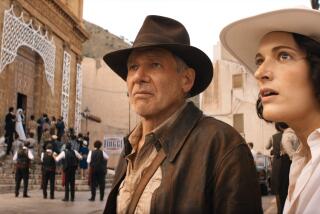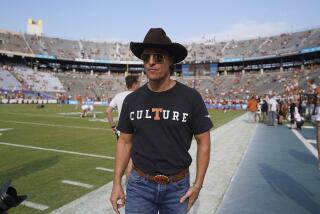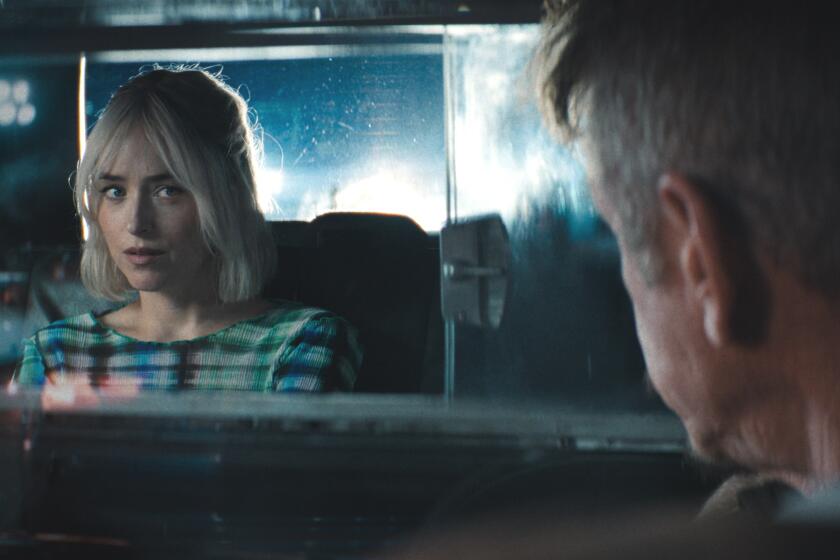George Clooney’s ‘The American’ has a European air
The first sequence of “The American,” like much of the rest of the movie, contains scarcely any dialogue. The scene unfolds in the snowy emptiness of Sweden, where Jack ( George Clooney) is hiking with Ingrid (Irina Björklund), a woman whose history with Jack isn’t revealed.
A sniper’s bullet tears through the frozen air, and in mere minutes the audience must puzzle out any number of critical questions. Who is Jack (whose real name might be Edward)? Why is someone trying to kill him? Why does he react as he does, particularly how he leaves his girlfriend?
Most movies from the big U.S. studios would doubtlessly provide responses in short order, but “The American” is content to leave many things — including a clearer explanation of what unfolds in the film’s opening frames — left unsaid and unanswered. Very loosely adapted from British author Martin Booth’s obscure 1991 novel, “A Very Private Gentleman,” director Anton Corbijn’s film, opening Wednesday, is a cinematic anomaly: a U.S. production that in look, pacing and casting is more European than Clooney’s own Italian villa.
“I’m sure a lot of people will think it’s on the slow side of things,” says Corbijn, whose previous film, 2007’s “Control,” was a critically acclaimed (but little seen) fictionalized biography of Ian Curtis, the lead singer of the British post-punk band Joy Division who committed suicide in 1980. “But I think there is too much explaining in films sometimes. Yes, there’s not a lot of back story on George’s character. But it’s enough for me to follow the metamorphosis that he is trying to achieve.”
As in the book, Jack is an accomplished and precise craftsman, but what he is meticulously creating in the workshop isn’t a handmade violin or a ship in a bottle: They’re high-powered weapons used for assassinations. Jack wastes little energy worrying about the principles of his calling — it’s his job, he’s good at it and he takes as much pride in his handiwork as a gourmet chef might show for a faultless beef Wellington — and in Booth’s novel he actually believes he’s providing something of a public service, a critical cog in the gears of history.
Like almost anyone with an illicit past, Jack must constantly watch the shadows, and as Corbijn’s film begins, Jack is looking to get out — with one last automatic rifle to build for a female shooter named Mathilde ( Thekla Reuten). He heads to a medieval Italian town in Abruzzo to escape his pursuers and build his final gun, and while there he meets Father Benedetto (Paolo Bonacelli) and the prostitute Clara ( Violante Placido), who independently conspire to reveal a bit of Jack’s hidden soul.
“The American” is very much a tale of a man alone, and to highlight that vision the filmmakers not only switched its protagonist’s nationality (he’s English in the novel) but also surrounded Clooney with a cast and crew almost exclusively European. At a very late stage, Corbijn even recast the part of Jack’s boss, replacing U.S. actor Bruce Altman with the Belgian performer Johan Leysen.
Rather than pack pages of expositional dialogue into the script (credited to Rowan Joffe, following drafts by numerous other writers over years of revisions), Corbijn, who is best known as a photographer, relied on long, lingering shots of Jack and the Italian countryside. “We were trying to make,” the director says, “a film that had a lot of beauty in it.”
That tricky juxtaposition — beauty and ugliness, life and death, heaven and hell — presented any number of obstacles in getting “The American” made. Producers Anne Carey, Ann Wingate and Jill Green optioned Booth’s book a decade ago, and the script passed through the keyboards of Nicholas Kazan (“Reversal of Fortune”), Danis Tanovic (“No Man’s Land”), Caspian Tredwell-Owen (“The Island”) and Laura Harrington before Focus Features was ready to make the $20-million movie.
The challenges were obvious. In addition to having a barely discernible moral compass, the book reads like a narcissist’s memoir — it’s almost all interior reflection. “The book is an almost random selection of memories,” Corbijn says. “There was not really that much emotion displayed, and it was so internal.” Any action is fleeting as well; the film’s opening Swedish shooting doesn’t appear in Booth’s book until Page 205.
“There had been versions that had been closer and further away” from the novel, Carey says. But she and her producing partners remained drawn to Booth’s central pursuit of redemption. “Can this guy change his life? Should he be allowed to change his life? Can you put down your gun and live your life? That was the organizing idea behind the movie,” Carey says.
Corbijn shared the sentiment. “I looked at the film like a western, a morality tale of good versus evil,” he says. “Someone has done something bad and wants to escape it, but the past catches up to him.”
Reflecting the suggestion of transformation, Clooney’s character sports a large tattoo of a butterfly between his shoulders (in the novel, the character paints the insects as a cover for his real profession, but in the film he pretends to be a photographer). And to show that Jack wasn’t the only person wrestling with his past, the filmmakers gave the priest an out-of-wedlock son.
But could Jack really be reborn? Would the movie mirror the book’s mixed but ultimately upbeat ending? Could Jack and Clara drive off into the Italian sunset? Those queries sparked any number of rewrites and debates, changes that ultimately overlapped with Clooney’s casting.
“George and I had both seen ‘Control’ and were huge fans of the film. That’s a huge part of the puzzle when George is considering working with a director,” says Clooney’s producing partner, Grant Heslov, who is also an “American” producer. “Even though ‘Control’ is a very different kind of story, it’s beautiful. But it’s hauntingly beautiful. It’s not commercially beautiful,” Heslov says.
Clooney, who subsequently will be seen in writer-director Alexander Payne’s “The Descendants” in 2011, ultimately weighed in on how he thought the movie should end. Without giving anything away, he made an unusual choice.
“This wasn’t one where we said, ‘We’re doing an “Ocean’s Eleven” franchise,’” Heslov says of the film’s overall European tone and structure. “On a $70-million film, it’s less of an art form. That’s just a fact. Anton is an artist. And he’s never going to tell a movie in a straightforward way. He’s willing to sit on a shot for a while and not cut away. There are going to be people who are going to be absolutely frustrated by it.”
Clooney says in an e-mail message that that’s specifically why he wanted to make “The American.”
“We wanted to do a movie in the vein of the ‘70s foreign films that influenced so many great filmmakers today,” Clooney says. “We felt if we kept the budget low, that the outside influences (like a studio) would be minimal and we were lucky that Focus was on board with the concept from the beginning.”
john.horn@latimes.com
More to Read
Only good movies
Get the Indie Focus newsletter, Mark Olsen's weekly guide to the world of cinema.
You may occasionally receive promotional content from the Los Angeles Times.










